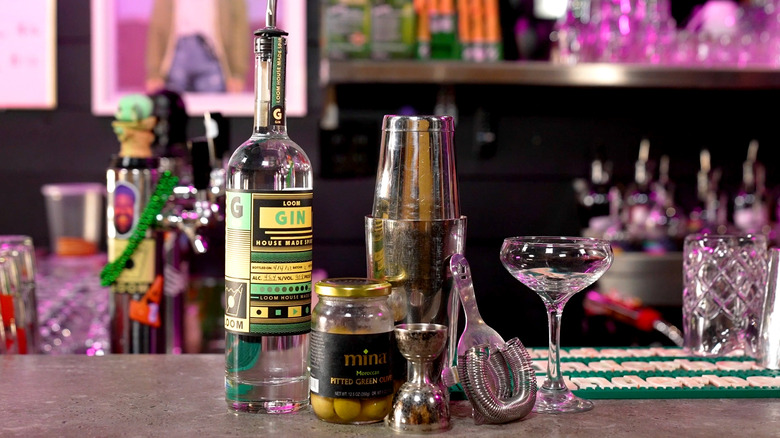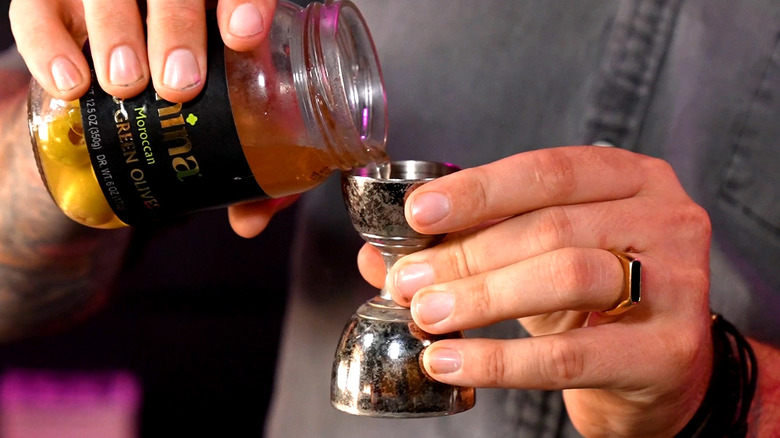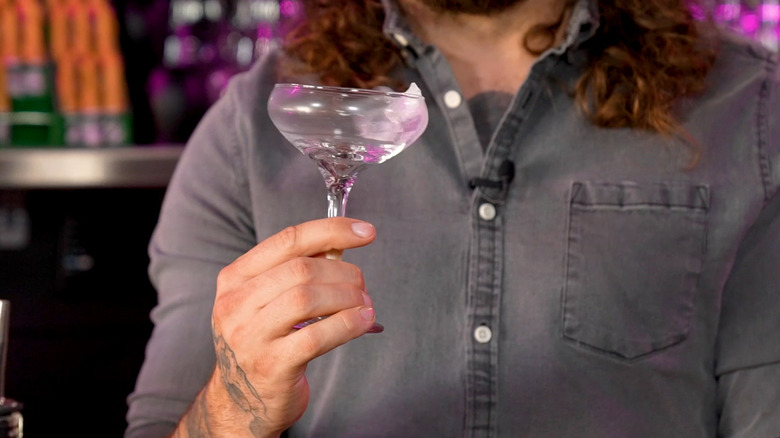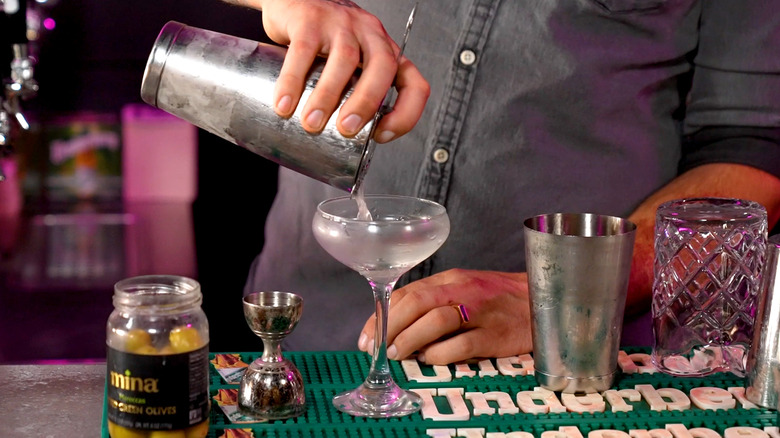How To Make A Dirty Martini–You're Doing It Wrong All Wrong
The dirty martini — a mix of gin or vodka and olive brine — is one of life's guilty pleasures. Simple, fun, social, a bit of a '90s throwback, it's immensely popular and eminently drinkable and delicious. So it might be easy to assume that making one is a no-brainer. Pour booze into a shaker, maybe add some vermouth, some olive brine, add ice, shake, and serve. Or keep your ingredients in the fridge, pour them straight into a cup, and stir with your finger. Done.
But in fact, for any drink, even a casual two-ingredient party drink, there's a right way and wrong way to make it. After all, a traditional martini consists of only two ingredients, yet over the years bars have created so much ritual around the martini that it's considered one of the poshest of drinks.
As Chowhound's recipe developer Kamaron Lockwood shows in this "You're Doing It All Wrong" video, the key to an ideal, well-savored dirty martini is knowing exactly which ingredients you prefer, in what proportions, and making the drink with the same care given to any elaborate craft cocktail. Blindly guessing is a mistake you won't want to make.
Ask the right questions
The first step to a successful martini is knowing what you want, which can be difficult with drinks that people order frequently, but don't always understand precisely how they like it. Lockwood has a litany of questions geared to making certain his guests receive exactly what they're hoping for and you should ask yourself the same.
"I usually always ask, do you want gin or do you want vodka? How dirty would you like it?" explains Lockwood. "And I always ask if they want it shaken or if they want it stirred. And then garnish."
The key variables, then, are the base spirit, how much brine to use (aka how dirty the martini should be), shaken or stirred (which affects the texture and ice), and what garnish you'd like, which can vary from olives to twists of citrus. Ultimately each option is a matter of preference, but these choices are pronounced in a drink as simple as a martini. "These are very important questions to ask," says Lockwood.
The point is, why be disappointed with a drink that doesn't meet your expectations? It's one reason people who make the same drink at home that they order at a bar are never quite satisfied. All this is to say, know what you like and go in with a game plan so you come out with a dirty martini you'll like.
Deciding how dirty your martini should be
While most of the choices you make for your dirty martini are a matter of a simple swap, the question that's going to affect your martini making process the most is how dirty you want your drink to be. Lockwood asks his guests, "How dirty would you like it? Would you like it slightly dirty, would you like it pretty standard, regular dirty, would you like it filthy dirty?"
The "dirty" part of a dirty martini is actually the brine from a jar of olives. You can also buy brine on its own, marketed specifically for dirty martinis. How much you add influences the saltiness and look of the finished drink.
"People are usually pretty good at letting you know just how dirty they want it," Lockwood says. "If somebody orders a slightly dirty martini, I start in ¼-ounce increments, then work my way up from there," says Lockwood. "If somebody asks for absolutely filthy dirty ... typically I go an ounce, and sometimes even an ounce and a half." If you're not quite certain, aim for between ¼ and ½ ounce. "Anything over ½ ounce is starting to get into the filthy territory," Lockwood explains.
Prepare everything you need
Prepping ingredients in advance and having the proper tools (they don't have to be fancy) will go a long way to making the finished cocktail the best it can be. A key element, according to Lockwood, is chilling down the cocktail glass. The finished drink doesn't have ice, so a room-temperature glass warms your drink. To avoid this mistake, Lockwood adds a few ice cubes and swirls them in the glass for 10 or 20 seconds, setting it down to chill while he works. When you're done, dump the ice and shake the glass to remove any meltwater. You can also pop the glass into the fridge or freezer for 15 minutes, but this requires advance notice. Either way, "it definitely is going to help," he says. "The colder the martini is, the more enjoyable it's going to be."
This drink can be shaken or stirred. A shaken dirty martini blends and emulsifies the ingredients nicely, giving you that velvety texture with fun ice chips — in which case you'll want a quality cocktail shaker. On the other hand, some people prefer a stirred dirty martini. For this, stirring the drink in a mixing glass (or pint glass) avoids the ice chips and creates a cold, "cleaner" version according to Lockwood.
Having proper glassware on hand is also ideal. Use a V-shaped martini glass or the older coupe style (Lockwood calls it an up glass). They're best for ice-free cocktails, and present well. After all, what's better? Dumping everything into a red plastic cup, or taking your time to make a proper cocktail in the proper glass?
Putting it all together
When it's time to make your drink, be sure and use a measured shot glass or jigger to pour your spirit and brine. It may seem like this drink lends itself well to casual pouring, but that would be a mistake. It's easy to pour too much alcohol, and that's not encouraged. Likewise, it's easy to make the drink too dirty, or not dirty enough.
In a shaker tin or mixing glass, add 2 ounces of gin or vodka. If you like dry vermouth, add ¼ or ½ ounce. Then add the olive brine (½ ounce if you're playing it safe). Add ice about ¾ of the way up either vessel, and shake or stir for 10 to 12 seconds. Lockwood prefers using a single Hawthorne strainer with shaken drinks, so the ice chips make it to the glass, providing a lingering cold texture he likes. But you can double strain while pouring to remove the chips. Strain directly into the chilled glass.
Finally, choose your garnish. Most common is two or three pimiento-stuffed green olives. But you can find olives stuffed with blue cheese, foie gras, or even wasabi. Or consider a lemon twist or peel. It's really up to you. Put it all together and dodge common mishaps, and you've got yourself a dirty martini that's delightfully chilled, umami-rich, and perfectly proportioned.



